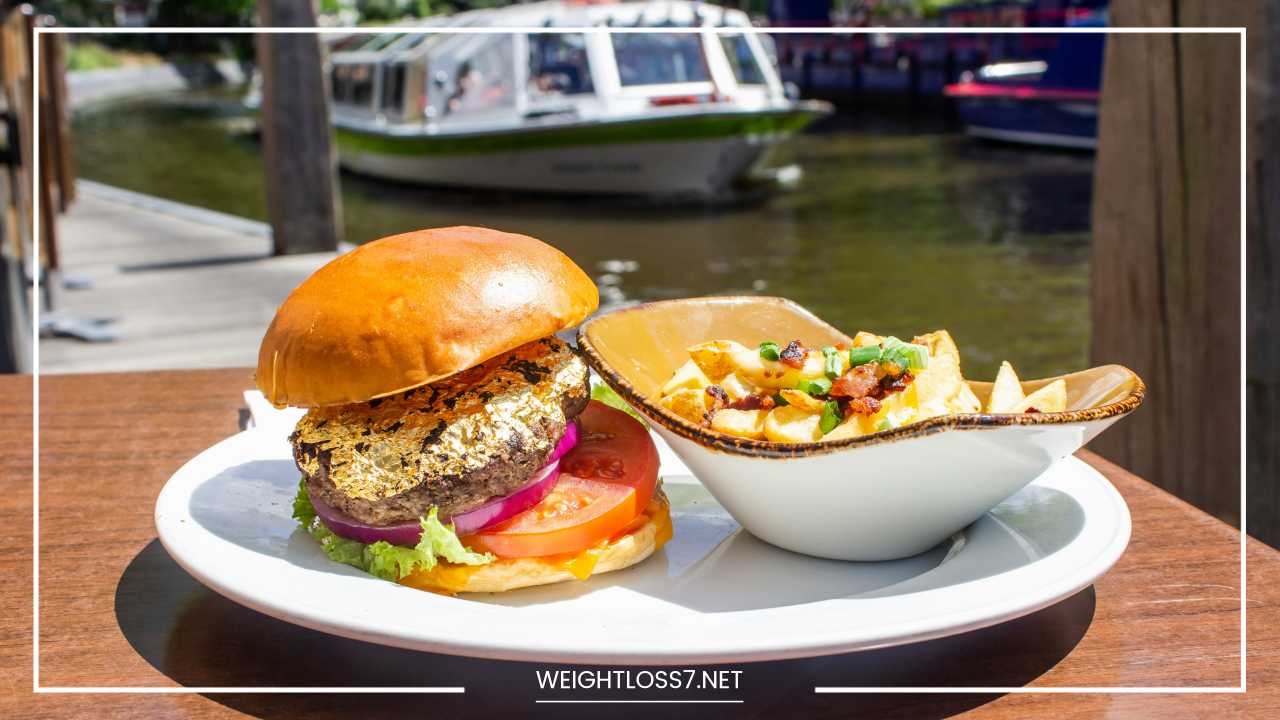Fast Food’s Healthier Trends

Fast Food Innovation
Fast Food’s Fresh Start: Unveiling Healthier Trends
For decades, the image of fast food conjured greasy indulgence – a quick and convenient bite that often came at the expense of our health. But a revolution is brewing in the drive-thru lane.
Consumers are demanding more, and the fast-food industry is responding with a wave of healthier trends that are transforming the way we think about grabbing a meal on the go.
This shift isn’t driven by a fleeting fad; it’s a response to a growing cultural awareness of healthy eating. People are more informed about nutrition than ever before, and they’re looking for ways to incorporate healthier choices into their busy lives.
Fast food chains are wise to cater to this growing segment by offering fresh, innovative options that don’t compromise on flavor or convenience.
The Plant-Based Revolution
One of the most significant trends is the rise of plant-based options. Vegetarian and vegan diets are gaining traction, and fast food chains are taking notice.
From succulent plant-based burgers that sizzle just like their beef counterparts to flavorful veggie wraps and creative salads, there’s a growing abundance of meat-free choices.
These options aren’t just for vegetarians; they appeal to flexitarians, those who are reducing their meat consumption, and even curious carnivores looking to explore new tastes.
Beyond the Beef Patty: A Protein Powerhouse
Even for meat lovers, the focus is shifting towards healthier protein sources. Leaner cuts of chicken, turkey, and fish are making their way onto menus.
Grilled options are replacing greasy fried favorites, offering a lighter and more flavorful alternative. Fast food chains are also experimenting with interesting protein blends, combining lean meats with vegetables or whole grains for added nutrients and flavor.
This approach caters to a wider range of dietary needs and preferences, from high-protein seekers to those seeking a more balanced meal.
Salads: From Sidekick to Star Player
Salads are no longer relegated to the side dish category. Fast food chains are offering gourmet salad options with a variety of fresh ingredients that go beyond iceberg lettuce and uninspired toppings.
Think chopped kale, quinoa, roasted vegetables, grilled meats, and flavorful vinaigrettes. Today’s fast-food salads are packed with flavor and nutrition, making them a satisfying and convenient meal choice.
Whole Grains Get Their Due: A Focus on Fiber and Balance
The era of white bread buns is slowly fading. Fast food restaurants are introducing whole-wheat options and experimenting with grain bowls that combine protein, vegetables, and whole grains for a balanced and filling meal.
This focus on whole grains provides a slower release of energy and keeps you feeling fuller for longer. It also introduces essential dietary fiber, which has been linked to improved digestion, gut health, and even lower cholesterol levels.
Transparency on the Table: Building Trust Through Openness
Consumers are increasingly interested in where their food comes from and how it’s prepared. Fast food chains are responding by offering more transparency about their ingredients and sourcing practices.
This includes highlighting the use of cage-free eggs, antibiotic-free meats, and locally sourced produce. Transparency builds trust with customers who are looking for ethically sourced and sustainable options.
Technology for Informed Choices: Empowering Customization
Technology is playing a crucial role in the healthy fast-food revolution. Mobile apps allow for customization of orders, letting you swap fries for a side salad or add a protein boost to your salad.
Imagine building your own healthy bowl with a base of quinoa, grilled chicken, roasted vegetables, and a light tahini dressing – all through a user-friendly app.
Nutritional information is readily available online and through apps, empowering you to make informed decisions about your meal based on your calorie needs and dietary restrictions.
Healthy Doesn’t Have to Mean Bland: Exploding Flavor Profiles
One of the biggest misconceptions about healthy fast food is that it has to be bland or boring. Thankfully, this isn’t the case. Today’s healthy fast food is bursting with flavor.
Chefs are getting creative with spices, herbs, and innovative flavor combinations, proving that healthy can be delicious.
Think chipotle-lime chicken bowls, Korean BBQ beef wraps, or Mediterranean falafel pitas – all offering bold taste profiles without sacrificing nutritional value.
Is it Sustainable? Addressing Environmental Concerns
While the rise of healthier options is a positive step, there are still questions about the sustainability of these practices.
Fast food packaging often generates significant waste, and some meat alternatives may have a high environmental footprint. The industry needs to find ways to offer healthy options in eco-friendly packaging.
This could involve using recycled materials, compostable containers, or encouraging reusable options. Additionally, sourcing practices for plant-based ingredients need to be scrutinized to ensure they’re not contributing to deforestation or water overuse.
The Future of Fast Food: A Glimpse into Innovation
The future of fast food is looking bright. As consumer demand for healthy and convenient options continues to grow, we can expect to see even more innovation in the industry. Here are some exciting possibilities:
- Personalized Nutrition Plans: Imagine a future where fast food chains utilize data and AI to offer personalized nutrition plans. Through loyalty programs and app integration, these plans could recommend meals based on your individual dietary needs, preferences, and even activity levels.
- Hyper-Local Sourcing: Fast food chains might increasingly source ingredients from local farms, offering seasonal and regional specialties. This would not only enhance the freshness and flavor of the food but also support local agriculture and reduce the environmental impact of transportation.
- Vertical Farming Integration: Some fast food chains might even explore integrating vertical farming techniques into their operations. Growing fresh produce on-site would ensure peak freshness and minimize the need for long-distance transportation.
- Culinary Innovation with Plant-Based Proteins: The development of plant-based proteins is rapidly evolving. We can expect to see even more realistic and flavorful meat alternatives emerge, offering a wider range of textures and tastes.
- Focus on Gut Health: The gut microbiome is increasingly recognized as playing a crucial role in overall health. Fast food chains might introduce options that promote gut health, incorporating prebiotics and probiotics into their recipes.
- Automation and Efficiency: Increased automation in kitchens could lead to faster service times and more consistent quality. Additionally, optimizing logistics and streamlining operations can enhance efficiency and potentially reduce costs, allowing for more affordable healthy options.
Challenges and Considerations
While the future of fast food is brimming with possibilities, there are challenges to consider. Here are some key areas:
- Cost and Accessibility: Ensuring that healthy options remain affordable and accessible to everyone is crucial. Balancing healthy ingredients, sustainable practices, and affordability will be a key challenge for fast food chains.
- Labor and Training: Implementing new technologies and innovative menu items might require additional training for staff. Investing in workforce development will be essential to ensure a smooth transition and high-quality service.
- Marketing and Customer Perception: Changing the public perception of fast food as unhealthy will require effective marketing strategies. Highlighting the health benefits, fresh ingredients, and innovative flavors will be key to attracting new customers.
The Bottom Line: A Healthier Future for Fast Food
The rise of healthier options in the fast-food industry is a welcome change. It empowers consumers to make informed choices and incorporate healthier options into their busy lives.
While challenges remain, the industry’s willingness to adapt and innovate is a positive step towards a healthier future for fast food.
By embracing transparency, sustainability, and technology, fast food chains can continue to evolve and offer convenient, delicious, and nutritious options for everyone.
Making Smart Choices: Your Guide to Fast Food Navigation
The next time you find yourself at the drive-thru, remember these tips to navigate the fast-food landscape and make smart choices:
- Plan Ahead: If you know you’ll be relying on fast food, browse menus online beforehand and choose the healthiest option that fits your dietary needs and preferences.
- Portion Control is Key: Even healthy options can be high in calories if you supersize them. Opt for smaller portions or share a meal with a friend.
- Beware of Hidden Sugars: Salad dressings and sauces can be loaded with sugar. Choose lighter options or request dressings on the side.
- Focus on Whole Foods: Prioritize options with fresh ingredients and whole grains over processed foods.
- Balance is Everything: Fast food can be a part of a healthy diet, but it shouldn’t be the only source of nutrition. Focus on incorporating plenty of fruits, vegetables, and whole grains into your overall diet.
By making informed choices and embracing the healthier options emerging in the fast-food world, you can enjoy convenient meals without sacrificing your health. The future of fast food is looking brighter, offering a delicious and nutritious option for everyone on the go.
Deep Dive: Exploring Specific Healthy Trends in Fast Food
While we’ve explored the broader trends transforming fast food, let’s delve deeper into some specific, exciting developments:
1. The Rise of Veggie Burgers: Beyond the Beyond Burger
The now-iconic Beyond Burger was a game-changer, proving plant-based burgers could be juicy, flavorful, and satisfying. Today, the market is exploding with even more innovative options. Here are some exciting trends:
- Black Bean Burgers: These hearty patties offer a protein and fiber punch, often featuring bold Latin flavors like chipotle or black bean salsa.
- Beet Burgers: Earthy and slightly sweet, beet burgers add a unique twist to the classic veggie burger. They can be paired with interesting toppings like goat cheese or balsamic glaze.
- Mushroom Burgers: Portobello mushrooms offer a meaty texture and can be marinated in a variety of sauces to create different flavor profiles.
- Lentil Burgers: Lentils are a fantastic source of protein and fiber. Lentil burgers can be seasoned with Indian spices or herbs like rosemary and thyme for a flavorful twist.
2. Redefining Salads: From Afterthought to Main Course
Salads are no longer relegated to the side dish category. Here’s how fast food chains are making them a star:
- Chopped Salad Craze: Chopped salads offer a more textural and flavorful experience compared to traditional iceberg lettuce salads. They often feature a variety of ingredients like chopped vegetables, nuts, seeds, and dried fruits.
- Global Salad Inspiration: Fast food restaurants are drawing inspiration from international cuisines, offering options like Thai peanut chicken salad, Greek salad with feta and olives, or a Mexican chopped salad with corn, black beans, and avocado.
- Build-Your-Own Salad Bars: Some chains are offering customizable salad bars, allowing you to choose your greens, protein, toppings, and dressing to create a salad that perfectly suits your taste.
3. Grain Bowls: A Celebration of Whole Grains
Grain bowls are a fantastic way to incorporate whole grains, protein, and vegetables into a single meal. Here’s how fast food chains are getting creative:
- Quinoa Bowls: This nutrient-rich grain provides a complete protein and pairs well with a variety of ingredients like roasted vegetables, grilled chicken, or tofu.
- Brown Rice Bowls: A classic base for grain bowls, brown rice offers a nutty flavor and sustained energy release. It can be topped with options like teriyaki chicken, black beans and salsa, or a Korean BBQ beef Bulgogi bowl.
- Cauliflower Rice Bowls: A low-carb alternative to traditional rice, cauliflower rice offers a similar texture and can be flavored in endless ways.
4. Alt-Protein Exploration: Beyond Burgers
Plant-based innovation is expanding beyond burgers. Here are some exciting possibilities:
- Plant-Based Chicken Nuggets: These meatless nuggets offer a familiar, kid-friendly option that’s also kinder to animals and the environment.
- Plant-Based “Fish” Alternatives: Made from seaweed or other plant-based ingredients, these options can be battered and fried for a delicious and sustainable alternative to traditional fish and chips.
5. Healthy Snacking on the Go
Fast food isn’t just about meals anymore. Here are some healthy snack options emerging:
- Trail Mix Bars: Made with nuts, seeds, dried fruit, and whole grains, these bars offer a satisfying and portable snack.
- Yogurt Parfaits: A parfait layered with yogurt, granola, and fresh fruit is a delicious and nutritious on-the-go option.
- Veggie Sticks with Hummus: This classic combination provides a good dose of protein, fiber, and healthy fats.
Final Word: A Balanced Approach to Fast Food
The future of fast food is all about offering convenient, delicious, and healthy options for everyone. By embracing these trends and making informed choices, you can navigate the fast-food landscape and enjoy meals that fit your lifestyle and dietary needs.
Remember, a balanced approach is key. Fast food can be a part of a healthy diet, but it shouldn’t be the only source of nutrition. Focus on incorporating plenty of fruits, vegetables, and whole grains into your overall diet for optimal health and well-being.

















